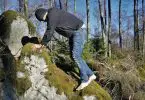Trekking poles are of great appeal to hikers, backpackers and day walkers, although many do not know how to use trekking poles to their best advantage. Walking or trekking poles are designed to give the hiker maximum support so that they provide propulsion.
Trekking poles are usually built with hard metal or carbide tips at the pole ends. Whether walking on flat ground or climbing steep hills, poles have the ability to increase your average speed, allowing you to cover greater distances.
Think of trekking poles as your extra legs. This means with these extra legs, you get extra stability, allowing you to hike quickly and for long distances. So, to cut the story short, trekking poles are not for sissy, they can make a big difference on your hike.
See also: How to Hike: Overcoming the Elements of Mother Nature for Newbies
But first, you have to know how to use them properly. Below we have explained the methodical and systematic approach describing ways on how to use trekking poles to your advantage by making your hiking easier, safe and more efficient.
Using Trekking Poles
Adjusting pole length
You cannot master the use of trekking poles properly if they are either too long or too short, therefore your new legs must be at your suitable length firstly. Adjusting the top of the pole to line up with your belt-line is a good starting point.
You may go longer for steep downhills or shorter for steep uphills. You can keep the top section completely out and use the lower section to adjust to the proper height. Setting the height a little shorter allows you to clear plants or rocks with less lifting.
Some may prefer a pole that is slightly longer while others prefer one that is slightly shorter. Try different heights and see which one suit you best. Then make sure that everything has been adjusted before heading off, and you’re ready to go. It’s as simple as that.
Swing the poles with rhythm
Each pole goes forward when the opposite leg does. This pattern maximizes balance and lets your arms swing the way they do naturally when hiking. Our body does this to help maintain smooth balance as we move.
With hiking poles, it’s no different. As you step forward with your right foot, also plant the left pole forward. Create a rhythm and put some energy then you will find out that you can literally push yourself forward with the poles. With a little practice, a smooth rhythm can be found with hikers experiencing the benefits of walking, particularly when walking uphill.
Walking with poles can help you establish and maintain a consistent rhythm, which can increase your speed.
Position the wrist strap
A wrist strap is one of the things people never take seriously and in fact, most people do not even know how to use them.
To position the length of the strap, slip your hand up through the wrist strap and tighten for comfort, such that when you open your palm, you won’t find it hard to grab your pole handle. i.e. the strap should do more work than your hand, but make sure it’s able to suit your wrist. When a wrist strap is correctly used, it goes a long way in preventing sprained wrists and aching hands.
Walking Technique with Poles
Most walkers use their trekking poles inefficiently by placing the pole tip slightly in front to use the pole as support and bending their arms at the elbow.
A more effective way is to use your shoulders to propel yourself forwards and keep your arm in a neutral position. Below are some of the walking techniques that will help you use your trekking poles more effectively.
Walking downhill
When using trekking poles to travel downhill the first thing to do is remove your hands from the straps and make sure you engage the shock system of the pole to lessen the impact of the fall especially when you have a backpack.
If the terrain is very muddy, steep, or icy, one effective technique is to have one short pole and the other one long. This will help you alternate them at each turn without any need to adjust every minute but still ensure you test both pole lengths to make sure they are suitable for the terrain.
Walking uphill
You should shorten the poles slightly on steep uphill sections of your walks. Engage in using your poles to push off not to help pull yourself up the hill by planting the tip of the pole in front of your lead foot to prevent yourself from doing this.
If the tip is too far forward, you will be wasting your energy by pushing the pole downward instead of backward. Try to keep your poles close to your body to improve efficiency when walking uphill.
Walking sidehilling
Sidehilling, or contouring, is when you walk sideways across a hill. One side will be higher than the other, all you have to do is shorten the uphill pole and lengthen the downhill pole.
In the case of lesser angles, grab the pole below the handle and this will give you equal balance and support on both sides.
Walking in mud and slush
You can keep your poles from sinking into the mud too deeply by making use of snow baskets or mud baskets on your trekking poles when conditions do get muddy and also to provide a little extra stability and balance for you. They can also help prevent the mud from splashing up onto your clothes when you are hiking.
Walking on flat ground
You will have your arms at 90 degrees when walking on flat ground. Step with your left foot forward and swing your right arm forward. Every step you take you’ll swing your arms just like you naturally walk.
The main idea is to push yourself forward with the poles, one side at a time. When you pick up the pole to swing it forward for the next step, try to keep it as low as possible, just above the ground, because the higher you lift the pole, the more energy you are using. Do read our review of the best Gore-Tex hiking shoes for more information.
Walking on rocky surfaces
If you are walking on a rocky surface, plant both trekking poles up where you are going and pulling yourself up. Sometimes you have to pull one up and one down to push and as you’re walking, make sure the tip of the pole doesn’t get caught in between two rocks.
If the tip is caught and you pull forward, it could break or bend. If this occurs, let the pole go back to the same angle it got caught and pull out straight. See our list of the top minimalist hiking shoes to help you navigate the road.
Things to Consider When Finding the Best Hiking Poles
- Weight: Depending on the material of the pole, every piece of hiking equipment should be lightweight. If you plan to travel with your poles or you are planning a multi-day expedition where every ounce-counts, weight is a very important factor.
With lightweight hiking poles you are able to move faster and easier, thereby saving energy. Lightweight poles are also easier to pack. - Shock Absorption: Some of the more advanced trekking poles do come with this feature. It’s great for lessening the shock impact on your way back down a trail but doesn’t offer much on the way up. This feature helps ease the pressure on joints.
- Handle: Pay attention to the handle, different material such as foam, rubber and cork are commonly used in the grips. Some of the handles are even ergonomically shaped. Cork is cooler than rubber and conforms to your hand. But rubber is the heaviest and foam feels the least cold.
- Material: Hiking poles are commonly made of aluminum poles and carbon poles. The aluminum poles are heavier than the carbon but carbon poles are stronger, though they cannot withstand dents or bangs and can get cracks and be useless. Aluminum poles are more durable and can still be functional even with a bend.
Benefits of Trekking Poles
Gone are the days when a random stick found in the woods was used for balance and stability. Today, trekking poles made out of aluminum or carbon fiber materials, have replaced the stick as a means of support.
There are several benefits to enjoy when you use trekking poles. When used correctly, trekking poles can significantly increase your pace, which has additional health benefits. For the hiker who is yet to decide if or when to use trekking poles, a good place to start is by examining the benefits poles can offer. Here are some of the benefits of trekking poles.
- Stability and balance: The use of poles provides a walker with maximum support, and balance and improves posture, particularly when covering uneven ground and unfamiliar surfaces, such as river and stream crossings, rocks and slippery logs.
Recommended Reading: We’ve written a whole article on how to ford a river that you might be interested in.
This means that the trekkers can cover more ground quickly. The extra two points of contact with the ground will boost your confidence, especially if you are feeling fatigued towards the end of your walk.
With more points of contact, hikers are less likely to slip in the first place, and slips are less likely to turn into falls. However, you can energize yourself, retain three points of contact with the trail, and stay on your feet, despite a slip. - Better propulsion: Trekking poles increase your pace by using your poles to ‘push off’ from the ground; this will help you to increase your forward motion, thus increasing your speed.
Another great health benefit of using walking poles is that they improve posture, especially important if you are carrying a load. - Trekking poles will make you more conscious of being upright whilst walking. The poles will help you keep your body position more upright so you can use your arms and shoulders to propel yourself up the trail easier.
- Strength and fitness: With trekking poles, hikers use upper body muscles regularly while swinging. Using trekking poles will strengthen your muscles, creates a full body workout, and enhances the already significant aerobic benefit of hiking. Trekking poles can also increase the number of calories burned while hiking.
- Reduced effort: You can reduce your walking effort when using trekking poles, thus allowing you to achieve more during your walks. Less stress on your legs, knees, ankles, hip joints and feet with the use of trekking poles means you will enjoy more years of hiking.
Locking Mechanisms of Trekking Pole
Trekking poles come in two or three interlocking sections, which makes it possible to adjust their length. This adjustability allows you to adapt the poles to various heights and kinds of terrain.
Locking mechanisms are used to secure the poles at your desired length, and then keep them from slipping when they are in use.
Most poles make use of any one of the below types of locking mechanisms.
- External lever lock: This type of pole uses a clamp-like and lever-based mechanism that is easy and quick to adjust, even when you are hiking with your gloves on.
- Push-button lock: Trekking poles with this type of locking mechanism lock with a single pull. All you have to do is press a button to release the lock, and then the poles will be collapsible.
- Twist lock:The twist lock uses an expander and screw setup that is consistently strong and durable.
- Combination lock:This type of locking mechanisms helps you to achieve a balance of strength, ease of use, and lightweight quality. For example, this comes in the form of a twist lock on the lower shaft and external lever lock on the upper shaft.
Final Thought
Trekking poles enhance the stability and cardiovascular benefits of walking which significantly outweigh the occasional frustration. For most hikers, walking poles are helpful and recommended. If you have decided that trekking poles are the way to go, now it’s time to go out and confront the wide variety of brands, types, and styles of trekking poles available and select a pair of your own.
For the best trekking poles you can choose from, check out our article on this topic.
Featured Image Source: https://unsplash.com/photos/zW8NsaUruMU








